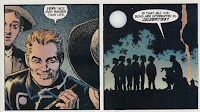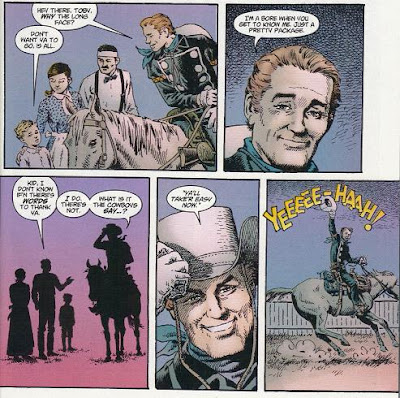 |
| Reintroducing Rawhide Kid in Issue #1. |
My introduction to the Western comic book genre came late in my collecting life in the rugged guise of the 2005
Jonah Hex, Volume 2, written by Jimmy Palmiotti and Justin Gray. The most familiar Western hero from DC Comics, I eventually found that because of its excellence, I craved more adventure from "those thrilling days of yesteryear."
 |
Cover to Issue #2 by Terry Dodson
and Kaare Andrews... subtle, right? |
My experience with Marvel Comics' Westerns began with more modern iterations of two key characters, The Rawhide Kid and the Two-Gun Kid, among others. Together they starred in the four-issue miniseries
Blaze of Glory (2000),
by writer John Ostrander and artist Leonardo Manco and its sequel,
Apache Skies (2002). Both The Rawhide and Two-Gun Kids were presented in fairly traditional Western fashion, consistent with the earlier roots of each character. The Rawhide Kid character originally debuted in 1955 from Marvel Comics's 1950s predecessor, Atlas Comics. Described as a "diminutive yet confident, soft-spoken fast gun constantly underestimated by bullying toughs, varmints, and crooked saloon owners," the Rawhide Kid (Johnny Bart) was the template from which later super-cowboys sprang. While the Rawhide Kid of
Blaze of Glory/Apache Skies was grittier than the original, both interpretations were very different than what would come next.
With a faint recollection of a news story about the Rawhide Kid being re-envisioned as homosexual in the early 2000's, I bought the individual issues of
Rawhide Kid, Volume 4 (2003) for cheap to see what the hubbub was all about. At the time, I missed the red flag that the subsequent trade paperback collection of the mini-series, bore the title of the story arc from the miniseries, "Slap Leather." From the start, the tone is sophpomric and most of the updated characterization is played for "laughs."
 |
Clue 1 from Issue #1: Rawhide Kid
likes celebrity gossip! |
As written by Ron Zimmerman, this Rawhide Kid (who inexplicably prefers the nickname "Trey"?!) is much more of a caricature of homosexual stereotypes than a fully realized character with a (presumably) less-than-common sexual orientation for the Old West setting. The inherent potential of exploring the challenges of such a character in the Old West are ignored for the sake of probing the intricacies of how two of the Cartwright Boys from
Bonanza could be placated by alcohol and potentially tricked into "extracurriculars" with Trey. I can't make this stuff up. Zimmerman sprinkles various literary and historical figures throughout the proceedings and even creates historical analogs for modern figures (for example, the dim-witted town leader, Mayor Bush) in an effort both ground his story in history and possibly, satire.
 |
| The flirtation begins in Issue #2. |
The plot is standard: gunman (The Rawhide Kid) comes to town beset by criminal types. While there, gunman teams-up with local lawman, previously humiliated by criminals, to save town, and the lawman's shaky relationship with his young son. It's in the execution and detaisl that things get awkward: gunman drops numerous romantic hints to the lawman about things like French fashion while parading around without his shirt. Lawman's son, embarrassed of his pa's failure, publicly and verbally emasculates dad while hero-worshiping the gunman who (wink-wink) is homosexual.
Though subsequently billed as "the first openly gay comic book character to star in his own magazine," the Kid's openness is almost entirely comedic in its presentation, limited to obvious campy humor, puns and double entendre. Used as simply a way to differentiate the protagonist from those around him (and as a subtle reasoning behind his colorful attire), the Kid's homosexuality fails to add a level of depth to the characterization or by extension, the title's proceedings.
 |
As seen here in issue #3, the Kid is
always on the cutting edge of fashion. |
The artwork by John Severin, a long time comic book artist who also provided art for Image Comics' modern-Western title
Desperadoes: Quiet of the Grave (2001), is excellent. While the detailed setting clearly established as Old West vibe, the accompanying story, by Ron Zimmerman, is surprisingly ham-handed and stereotypical in its reveal and depiction of the Kid's sexual orientation. It could be said to border on parody, but just what was being parodied is up for debate. The multiple references to literary (the leads of
Lonesome Dove get name-checked early on) and historical Western figures, as well as the beautiful artwork were not enough to carry me past the borderline offensive stereotype's of homosexuality that drove the story.
Even typography choices made by the writer and letterers, Rich and Wes @ Comicraft, seem to purposely reinforce the stereotypical depiction of our hero. As you can see from the pane at the top of the page, wherein the Rawhide Kid makes his first appearance wit the phrase "Oh,
stop..." which when read aloud with the proper emphasis applied for the bold lettering sounds somewhat affected. Upon my own internal reading an inflection was intended, as it is through out the series.
So, is it worth checking out? As a snapshot of the misguided attempt by a mainstream publisher to take an older character and re-boot him in such a way, yes. Despite the somewhat clumsy effort, Severin's art (and the ability to analyze the hell out of the whole package) is just enough to recommend it. Both
The Rawhide Kid: Slap Leather (2003) and it's sequel,
The Rawhide Kid: The Sensational Seven (2010) are available as trades at your local comic book store (or in the back-issue bin).
 |
| Happy trails, Trey! from Issue #5. |







No comments:
Post a Comment